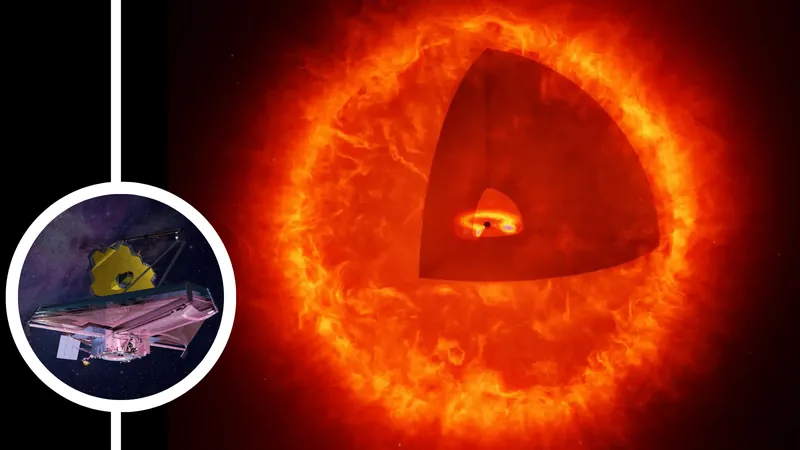
Are Those 'Little Red Dots' from the James Webb Space Telescope Actually Mysterious 'Black Hole Stars'?
2025-09-15
Author: Jessica Wong
A Shocking New Theory Emerges
New research proposes that the intriguing "little red dots" captured by the James Webb Space Telescope (JWST) might be an entirely new type of celestial object: black hole stars. If this groundbreaking theory holds true, it could unravel the mystery of how black holes grew to supermassive sizes in the universe's infancy, specifically before it even reached 1 billion years old.
Unveiling the Mystery of 'Little Red Dots'
These enigmatic red dots are among the most captivating sights revealed by the JWST. Astronomers suspect they represent early galaxies existing over 700 million years after the Big Bang, yet they defy expectations based on conventional galaxy formation theories. Interestingly, if they are indeed galaxies, they appear unusually mature and densely packed with aging red stars, leading some scientists to label them "universe breakers" due to their challenge to our understanding of cosmic evolution.
Rethinking the Nature of the Universe
Recent analyses suggest that these red dots may not be the well-formed galaxies we initially believed but instead enormous spheres of hot, dense gas that resemble stellar atmospheres. Unlike typical stars that derive energy from nuclear fusion, these objects boast supermassive black holes at their cores, voraciously consuming surrounding matter and emitting intense energy.
Joel Leja, a researcher from Penn State University, commented, "After examining enough red dots, we spotted one with so much atmosphere that it contradicted our expectations of typical stellar formations in galaxies. It’s like uncovering a colossal, extremely cold star instead of numerous cold stars clustered together."
A Bright New Understanding
This theory could illuminate why the little red dots appear paradoxically larger and brighter than what existing galaxy formation models would suggest. According to Princeton University’s Bingjie Wang, "A galaxy this luminous would require an impossibly high density of stars, making the sky astonishingly bright." If validated, this theory hints at the existence of star formation processes never before documented in the cosmos.
The Cliff's Crucial Role
Initially, scientists believed these dots were remnants of ancient galaxies. Their understanding shifted dramatically in July 2024 when they discovered a massive object colloquially named "the Cliff." Located around 12 billion light-years from Earth, this peculiar entity appeared crucial for examining the nature of the JWST’s red dots.
Ann de Graaff from the Max Planck Institute for Astronomy noted, "The extreme characteristics of The Cliff prompted us to rethink our models entirely. Its light spectra suggest it emanates from a single object rather than a cluster of stars, likely fueled by a supermassive black hole enveloped in a fiery gas sphere."
Deciphering the Birth of Supermassive Black Holes
While we know supermassive black holes reside at the core of large galaxies, their early formation remains elusive. The existence of supermassive black holes in such a young universe—less than 1 billion years old—complicates our understanding, as the conventional merging processes of larger black holes seem too slow to produce them in such a short timeframe.
The feeding process of these black holes, like the one found in The Cliff, is "turbo-charged," suggesting that these new black hole stars could provide insights into the growth patterns of supermassive black holes.
A New Frontier in Cosmic Exploration
Leja remarked, "The origins of these colossal black holes have remained a mystery. These black hole stars may represent the infant stages of black holes we observe in contemporary galaxies, hinting at their developmental phase." As the JWST continues to investigate these little red dots, researchers believe their theory aligns closely with the available data, awaiting further exploration and validation.
"This is our best working theory, and it aligns with almost all current observations. We’re excited to further investigate this phenomenon. The universe can be incredibly strange, and we know there are still immense surprises out there waiting to be discovered!"


 Brasil (PT)
Brasil (PT)
 Canada (EN)
Canada (EN)
 Chile (ES)
Chile (ES)
 Česko (CS)
Česko (CS)
 대한민국 (KO)
대한민국 (KO)
 España (ES)
España (ES)
 France (FR)
France (FR)
 Hong Kong (EN)
Hong Kong (EN)
 Italia (IT)
Italia (IT)
 日本 (JA)
日本 (JA)
 Magyarország (HU)
Magyarország (HU)
 Norge (NO)
Norge (NO)
 Polska (PL)
Polska (PL)
 Schweiz (DE)
Schweiz (DE)
 Singapore (EN)
Singapore (EN)
 Sverige (SV)
Sverige (SV)
 Suomi (FI)
Suomi (FI)
 Türkiye (TR)
Türkiye (TR)
 الإمارات العربية المتحدة (AR)
الإمارات العربية المتحدة (AR)